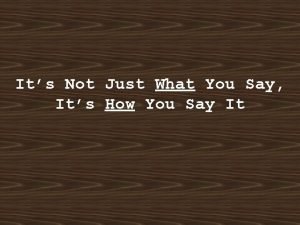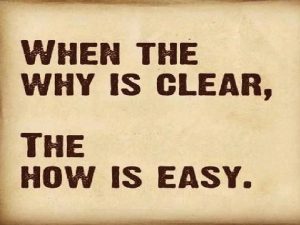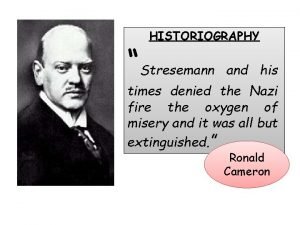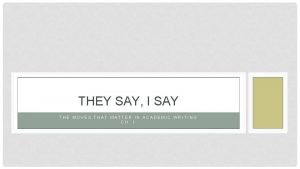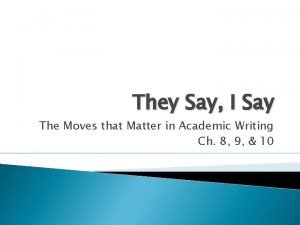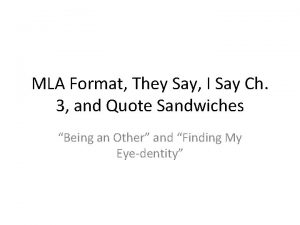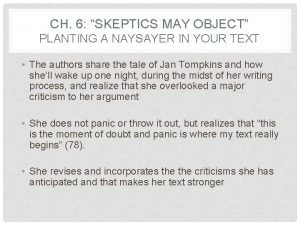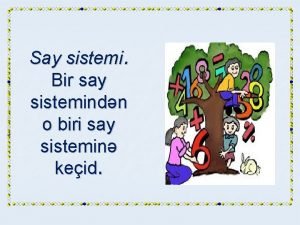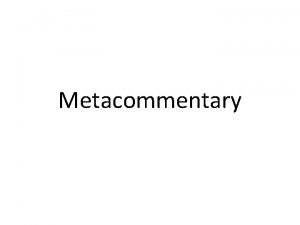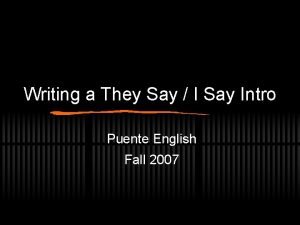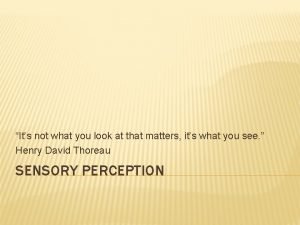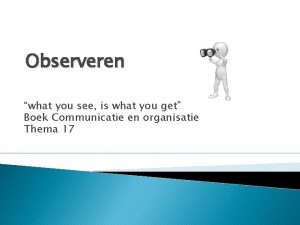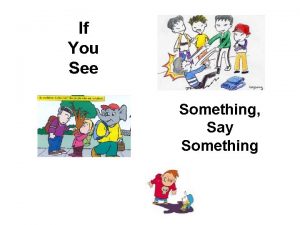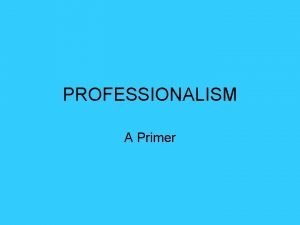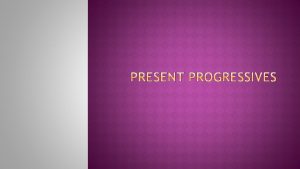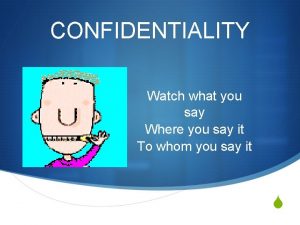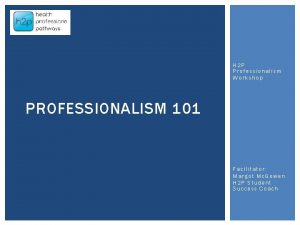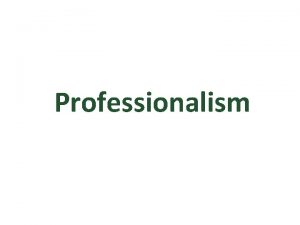If You See Something Say Something Managing Professionalism





























- Slides: 29

If You See Something, Say Something: Managing Professionalism Lapses in the Moment Maria Wamsley, UCSF Department of Medicine Juan Ruvalcaba, UCSF-Fresno Department of Family and Community Medicine February 17, 2016

Creative Commons License Attribution-Non. Commercial-Share Alike 3. 0 Unported You are free: • to Share — to copy, distribute and transmit the work • to Remix — to adapt the work Under the following conditions: • Attribution. You must give the original authors credit (but not in any way that suggests that they endorse you or your use of the work). • Noncommercial. You may not use this work for commercial purposes. • Share Alike. If you alter, transform, or build upon this work, you may distribute the resulting work only under a license identical to this one. See http: //creativecommons. org/licenses/by-nc-sa/3. 0/ for full license.

Roadmap • Causes of unprofessional behavior • Levels of managing professionalism lapses • Four-step process for responding to a professionalism lapse “in the moment” • Practice!

A case • It is 2 AM. A second year resident is on overnight call. The ICU is full and she is admitting a seriously ill patient with sepsis, in severe pain from metastatic cancer, to the floor. She is repeatedly called by the nurse from another floor about a patient on her coverage list. This patient was signed out with explicit instructions not to increase pain meds for his chronic pain. The patient is demanding to be seen. The nurse is insisting that she come to the floor. • After the fourth call, the resident screams at the nurse, uses harsh language in referring to the patient and slams down the phone, all in earshot of a busy nursing unit. The nurse then turns and snaps at the patient care assistant. 4

Professionalism values • Professionalism represents a set of values that guide our work: • Compassionate, Respectful, Collaborative Patient & family Department Staff Student • Pursuit of excellence Other health Resident • Integrity & accountability professionals • Fair and ethical stewardship of resources JAMA, December 22/29, 2010—Vol 304, No. 24 Faculty

Highly Publicized Illegalities Involving Health Professionals Disruptive Behaviors Conflicts of Interest Disregard of EBSP Daily Incivilities Collective Tolerance

Consequences of Unprofessional Behavior • Create an environment where unprofessional behaviors are modeled for others to emulate • Unprofessional behaviors are associated with • Low staff morale and turnover • Poor adherence to practice guidelines • Medical errors and adverse outcomes • Malpractice suits • Loss of patients

Why do Professionalism Lapses Occur?

Why do Professionalism Lapses Occur? Personal stressors • • • Competency Distractions Psychological Substance Abuse Physical Illness HALT: Hungry, Angry, Lonely, Tired Inter-Personal stressors • • Unshared mental models Disagreement Poor communication Poor understanding of role

Why do Professionalism Lapses Occur? Situational stressors • High workload • Emotion in clinical setting: • Death • Trauma • Violent patients • Angry families System stressors Inefficient workflow • • Conflicting policies • Culture • Hierarchical system

Opportunity for improvement (not a disciplinary event) Learning to address unprofessional behaviors in learners and colleagues starts with embracing a series of assumptions about professionalism: • We all aspire to adhere to the highest standards of professionalism but sometimes fall short of the mark. • We all would want to know if our behavior is not meeting professional standards; if our reputation as a professional is suffering because of patterns of maladaptive behavior. • We all have the potential to improve our behavior and attitudes with the help of our community of mentors, staff, and colleagues.

Levels of managing lapses Intensity Approach I) Low intensity end of spectrum Coaching in the moment & appears isolated II) Serious but isolated event Counseling/Conversation after the moment III) Persistent problem Correction & Consequences conversation IV) Egregious professionalism lapses or persist in actions despite coaching, counseling, or correction. Sanctions up to dismissal


Framework to coach for improvement opportunities In the Moment Coaching in the Moment: Four steps in 90 seconds Step Comment Recognize the underlying emotion “I” phrases are hard to argue with. Relate to the offender Displaying empathy lowers risk of defensiveness/verbal attacking or accusations. Re-establish the professionalism norm Connect the behavior back to the subject of the inappropriate comment as a humanizing moment. Redirect the conversation Moving on reinforces the coaching nature of the conversation.

Framework to coach for improvement opportunities In the Moment Coaching in the Moment: Four steps in 90 seconds Step Example Comment Recognize the underlying emotion “I see you’re upset. ” “I” phrases are hard to argue with. “I am sorry that this is so frustrating for you. ”

Framework to coach for improvement opportunities In the Moment Coaching in the Moment: Four steps in 90 seconds Step Example Comment “I can understand why you would feel frustrated in this situation. ” Displaying empathy lowers risk of defensiveness/verbal attacking or accusations. Recognize Relate to the offender “I have definitely gotten upset in similar situations; it’s understandable that you would feel frustrated. ” “I agree that it is challenging to manage conflicts like this. ”

Framework to coach for improvement opportunities In the Moment Coaching in the Moment: Four steps in 90 seconds Step Example Comment Recognize Relate Re-establish the “Let’s try to remember that the professionalism norm xxx’s are doing the best they can in this situation and likely also feel frustrated. ” “I find it helpful to remember that we all actually have similar goals; let’s not let how upsetting this is prevent us from working together effectively. ” Connect the behavior back to the subject of the inappropriate comment as a humanizing moment.

Framework to coach for improvement opportunities In the Moment Coaching in the Moment: Four steps in 90 seconds Step Example Comment “What can we do to help this patient? ” Moving on reinforces the coaching nature of the conversation. Recognize Relate Re-establish Redirect the conversation “Let’s work together on figuring out how to resolve this. ” “Maybe there’s a way to avoid this situation in the future. ”

Framework to coach for improvement opportunities In the Moment Coaching in the Moment: Four steps in 90 seconds Step Comment Recognize the underlying emotion “I” phrases are hard to argue with. Relate to the offender Displaying empathy lowers risk of defensiveness/verbal attacking or accusations. Re-establish the professionalism norm Connect the behavior back to the subject of the inappropriate comment as a humanizing moment. Redirect the conversation Moving on reinforces the coaching nature of the conversation.

Critical elements to the conversation • Makes it clear that you don’t endorse the situation • Stops the group from engaging in similar activity • Doesn’t call names– doesn’t accuse anyone of being unprofessional • Does express empathy for both the disruptor and those who were disrupted

A Case…

Practice! • Break into pairs • Decide who will be the “lapser” and who will be the “intervener” (you will switch roles for Case 2 so everyone has a chance to practice. • Read the part of the Case 1 that pertains to your role • Practice the 4 step framework (7 min) • For those of you who are the “lapser” please track how your “intervener” moves through the steps • Debrief in pairs (5 min)

Framework to coach for improvement opportunities In the Moment Coaching in the Moment: Four steps in 90 seconds Step Comment Recognize the underlying emotion “I” phrases are hard to argue with. Relate to the offender Displaying empathy lowers risk of defensiveness/verbal attacking or accusations. Re-establish the professionalism norm Connect the behavior back to the subject of the inappropriate comment as a humanizing moment. Redirect the conversation Moving on reinforces the coaching nature of the conversation.

Debrief

Practice! • Move on to Case 2 • Switch roles • Read the part of Case 2 that pertains to you • Practice the 4 step framework (7 min) • Debrief in pairs (5 min)

Framework to coach for improvement opportunities In the Moment Coaching in the Moment: Four steps in 90 seconds Step Comment Recognize the underlying emotion “I” phrases are hard to argue with. Relate to the offender Displaying empathy lowers risk of defensiveness/verbal attacking or accusations. Re-establish the professionalism norm Connect the behavior back to the subject of the inappropriate comment as a humanizing moment. Redirect the conversation Moving on reinforces the coaching nature of the conversation.

Summary • Professionalism is a skill to be practiced, not an inherent trait • Professionalism lapses are inevitable due to personal, interpersonal, situational and organizational stressors • Coaching in the moment is a strategy that can address professionalism lapses (4 R’s) • • Recognize the emotion Relate to the offender Recalibrate the correct behavior Redirect the conversation


Acknowledgement and Thanks • Catherine Lucey, MD • Maxine Papadakis, MD • Tess Lang, MD • Victor Laluz, MD
 Good afternoon me
Good afternoon me It's not what you say it's how you say it
It's not what you say it's how you say it What do you say after you say hello download
What do you say after you say hello download Smart is something you become not something you are
Smart is something you become not something you are 100 pics say what you see
100 pics say what you see Say what you see
Say what you see Say what you see
Say what you see Look at the picture and say
Look at the picture and say You say you love the rain
You say you love the rain They say / i say paragraph examples
They say / i say paragraph examples Metacommentary titles examples
Metacommentary titles examples They say i say by gerald graff and cathy birkenstein
They say i say by gerald graff and cathy birkenstein They say i say quotes
They say i say quotes 6 paragraph essay
6 paragraph essay They say / i say paragraph examples
They say / i say paragraph examples Voice markers they say i say
Voice markers they say i say Signal verbs they say i say
Signal verbs they say i say Quote sandwiches
Quote sandwiches How to plant a naysayer
How to plant a naysayer Templates for introducing quotations
Templates for introducing quotations Rum rəqəmləri 10000
Rum rəqəmləri 10000 They say i say chapter 10
They say i say chapter 10 How do you say puente in english
How do you say puente in english Fire and ice diamante poem
Fire and ice diamante poem Some say the world will end in fire some say in ice
Some say the world will end in fire some say in ice They say i say
They say i say It's not what you look at that matters, it's what you see.
It's not what you look at that matters, it's what you see. Major prophets
Major prophets Good morning good morning to you i am glad to see you
Good morning good morning to you i am glad to see you Rapporteren voorbeeld
Rapporteren voorbeeld

